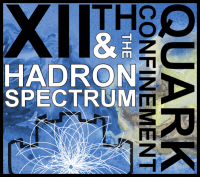Speaker
Description
The combination of multiple particle identification systems along with the excellent tracking capabilities makes ALICE a unique tool for the measurement of light flavor hadron production over a broad transverse momentum ($p_{\rm T}$) range.
The production of $\pi^{\pm}$, $\mathrm{K}^{\pm}$, ${\rm K}^{0}_{S}$, $\rm p$,
$\rm\overline{p}$, $\Lambda$, $\bar{\Lambda}$, $\Xi^-$, $\overline{\Xi}^+$, $\Omega^-$ and $\overline{\Omega}^+$ hadrons measured at midrapidity in proton-proton collisions at $\sqrt{s} =$ 7 TeV as a function of charged-particle multiplicity will be presented.
The observed multiplicity dependence of $p_{\rm T}$-spectra and their ratios is reminiscent of the behavior in Pb--Pb collisions, where the spectral shapes are interpreted in the context of a hydrodynamical evolution of the colliding system.
Moreover, the ratios of strange hadron production to the pion production are seen to increase with multiplicity, which is not the case for non-strange hadrons. The strength of the increase scales with the number of the strange valence quarks.
Commonly used Monte-Carlo models (e.g. PYTHIA8, EPOS LHC) are not able to reproduce our observations for pp collisions.
The talk will also include new ALICE results on light flavor hadron production in pp collisions at $\sqrt{s} =$ 13 TeV.




